Succession Planning: 6 Steps to Plan Ahead (+Template)
- Published:
- Updated: March 20, 2024


Successful companies always have a succession plan to replace keys leaders should a change happen with the organizational structure and in the event of employee turnover in critical roles. Creating a succession plan helps organizations identify and document critical skills and knowledge to pass it on to prepare their next-generation workforce for a seamless succession within the company.
Succession planning is of great value to organizations for facilitating knowledge transfer and employees’ formal, structured development.
What Is Succession Planning?
A succession plan identifies critical positions, future staffing needs, documenting and transferring key knowledge, and the people that could fill these future roles within an organization – and developing action plans accordingly.
A succession plan takes a holistic view of current and future company goals to ensure that you always have the right people in key roles in your organization.
In the long term, a succession plan strengthens the overall capability of an organization by:
- Identifying critical positions and highlighting potential vacancies
- Identifying key competencies and skills for business continuity in the event key leaders leave the company
- Documenting critical information to help facilitate knowledge transfer
- Focusing on employee development to meet future business needs
The Succession Planning Process
Here are the steps involved in a succession planning process.
1. Assess
The assessment phase in a succession plan includes
- Assessing an organization’s requirements.
- Identifying business challenges in the coming years.
- Identifying critical risk positions to support business continuity.
- Identifying competencies and skill gap.
2. Evaluate
The evaluation phase in a succession plan includes:
- Selecting high potential employees that would be chosen to replace key roles.
- Creating competency models to outline the skills needed by individuals to be successful in these new positions.
- Categorizing skill or competency gaps.
3. Develop
The development phase in a succession plan includes:
- Capturing the knowledge that individuals possess before leaving an organization.
- Creating handover documentation with contextual tasks and responsibilities.
- Developing a pool of talent to step into critical positions through career development plans.
Benefits of a Succession Plan
Let’s discuss a few benefits of succession planning:
1. Highlight skills gaps
Succession planning provides a risk assessment that uncovers vulnerabilities and skill gaps in your workforce. While looking for high-performing future leaders for your succession plan, weaker players are also highlighted who aren’t currently suited for their current job or lack specific skillsets.
These people analytics and insights enable HR and managers to investigate these employees further and provide the best support to become better performers and reach their career goals, taking the form of reskilling or upskilling programs.
2. Creates a structure for training and development
Once a company identifies potential employees for moving into senior positions, competency gaps can be easily identified for these employees to begin grooming for succession. This includes creating employee development and career plans to acquire the soft and hard skills, as well as the experience, they’ll need to perform well in their senior roles.
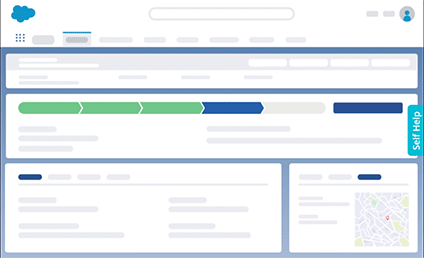
3. Long-term talent planning and retention
Another essential benefit of succession planning is improved employee retention of your top employees by offering them growth opportunities. Creating a long-term plan enables organizations to reduce their reliance on recruitment so that talent is only sourced externally as a last resort.
This also showcases to your best talent that you have a plan for them to grow into your leadership positions, and that your organization invests in its employees.
4. Direction for recruiting
A succession plan requires your company to identify internal candidates with values, skills, and desire to take on vacant critical jobs. And if there are no internal candidates who seem right for leadership positions, then recruitment teams are able to begin an external search early in the process.
Challenges of Succession Planning
There are a few challenges associated with succession planning, including:
1. Maintaining company morale
One of the side-effects of creating a succession plan for your organization is the negative impact on the morale of your workforce. The taboo of talking about moving on in one way or another can impede open discussion and threaten the importance of succession planning in organizations.
It also presents uncomfortable issues among employees, as team members will wonder why they were not chosen to replace the vacated role. To be effective, succession planning needs to be an open and transparent process where leaders openly discuss company structure and succession plans.
2. Underestimating the changing nature of work
An essential part of succession planning is anticipating future needs. Companies tend to overlook the fact that the introduction of the latest trends and technology keeps changing the nature of work. To create an effective succession plan, companies need to consider how these changes might impact the responsibilities associated with leadership positions and prepare the successors accordingly.
3. Failing to update the succession plan regularly
Companies spend a lot of time developing detailed succession plans, but this can become stalled in the implementation phase. This is a common mistake.
It is important to review and update your succession plan regularly. You should never go more than six months without reviewing your succession plan and re-evaluating the successor’s readiness to move into new roles.
Examples Of Succession Planning
There are a few different types of succession plans to consider, including leadership development and executive succession, departure planning, and emergency succession planning.
Let’s look at each of these examples.
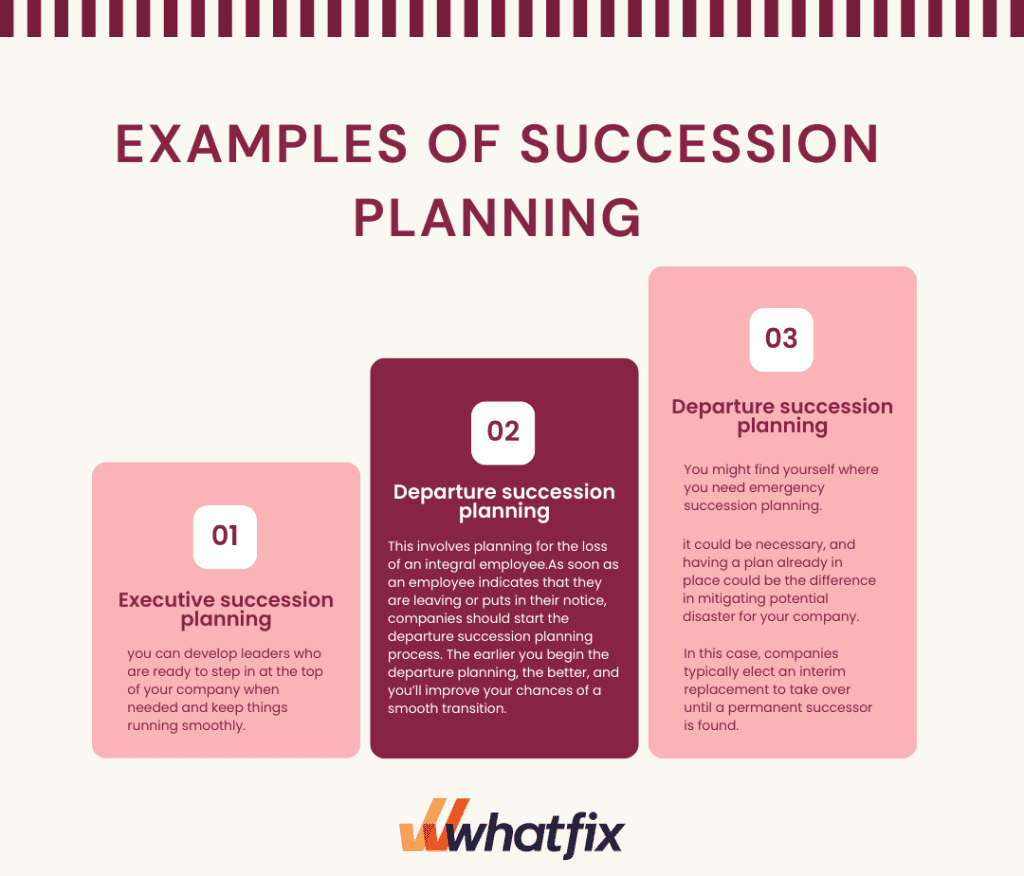
Executive succession planning
Executive succession planning is important as it pertains to the top leaders in your company. However, not every employee can be an executive and those that have potential need time and development. This is why executive succession planning is critical, so you can develop leaders who are ready to step in at the top of your company when needed and keep things running smoothly.
Departure succession planning
As the name implies, departure succession planning involves planning for the loss of an integral employee. As soon as an employee indicates that they are leaving or puts in their notice, companies should start the departure succession planning process. The earlier you begin the departure planning, the better, and you’ll improve your chances of a smooth transition.
Emergency succession planning
Finally, you may find yourself in a situation where you need emergency succession planning. While planning a succession during an emergency is never ideal, it could be necessary, and having a plan already in place could be the difference in mitigating potential disaster for your company. In this case, companies typically elect an interim replacement to take over until a permanent successor is found.
How to Create an Efficient Succession Plan
Follow these 6 steps to create an effective succession plan for your organization:
1. Assess your current workforce to identify critical and vulnerable positions
The first step in succession planning is to assess your current workforce to identify positions most in need of successors, or potential leaders that may be at risk of turnover.
Determining mission-critical positions is challenging and time-consuming. To make the process easier and to reduce the number of potential positions to assess, consider two major factors – vulnerability and criticality.
- Firstly determine which positions have no identifiable successors. These positions are most vulnerable to knowledge loss.
- Next, consider the impact each position has on the organization’s mission. Critical positions are the ones that have a direct impact on the organization’s ability to accomplish its mission.
2. Identify successors
After evaluating the positions for succession planning, the next step is to consider if current team members are capable of fitting into the role or have the potential to grow into it over time.
This requires you to look at employee performance objectively and carefully considering every individual for skills and emotional intelligence. Your highest-potential employees are lifelong learners who are excellent problem-solvers, adaptable, and able to take on responsibility.
The 9-box grid framework is a great tool to use to assess employee performance and enable succession planning.
The exercise maps employees against two axes: current performance and future potential. The vertical (y) axis indicates growth potential, referring to an individual’s potential to grow into leadership roles. The horizontal axis (x) represents an employee’s current performance, identifying whether they are below, meeting, or exceeding performance expectations.
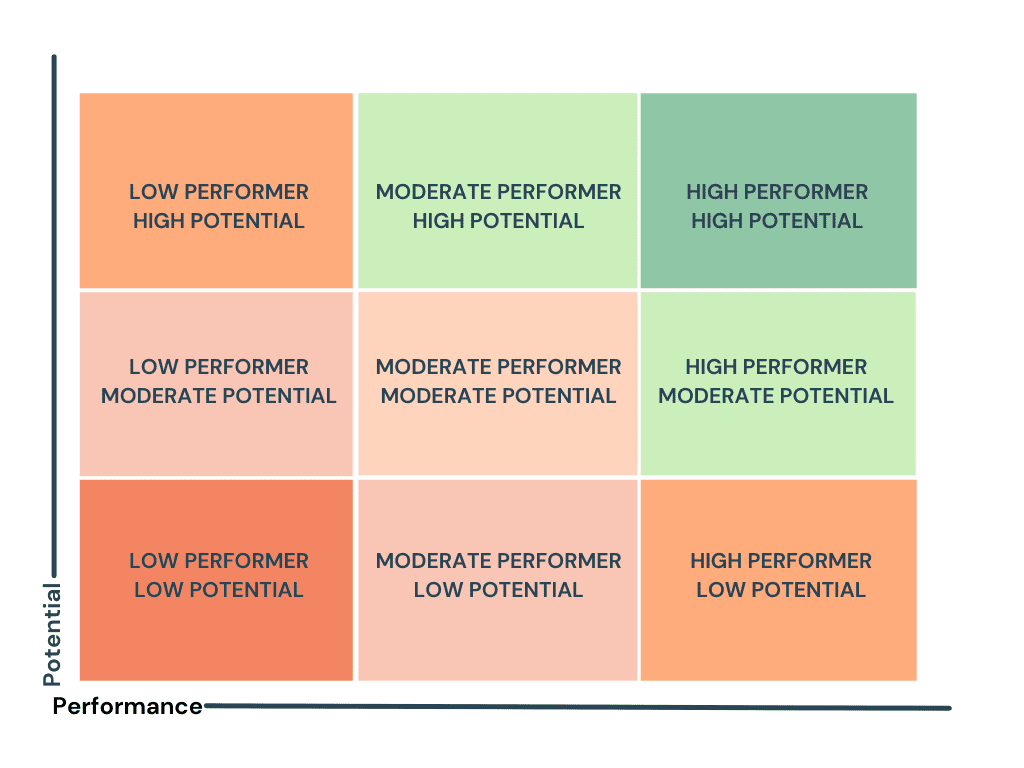
Here’s what your succession planning organizational chart will look like:
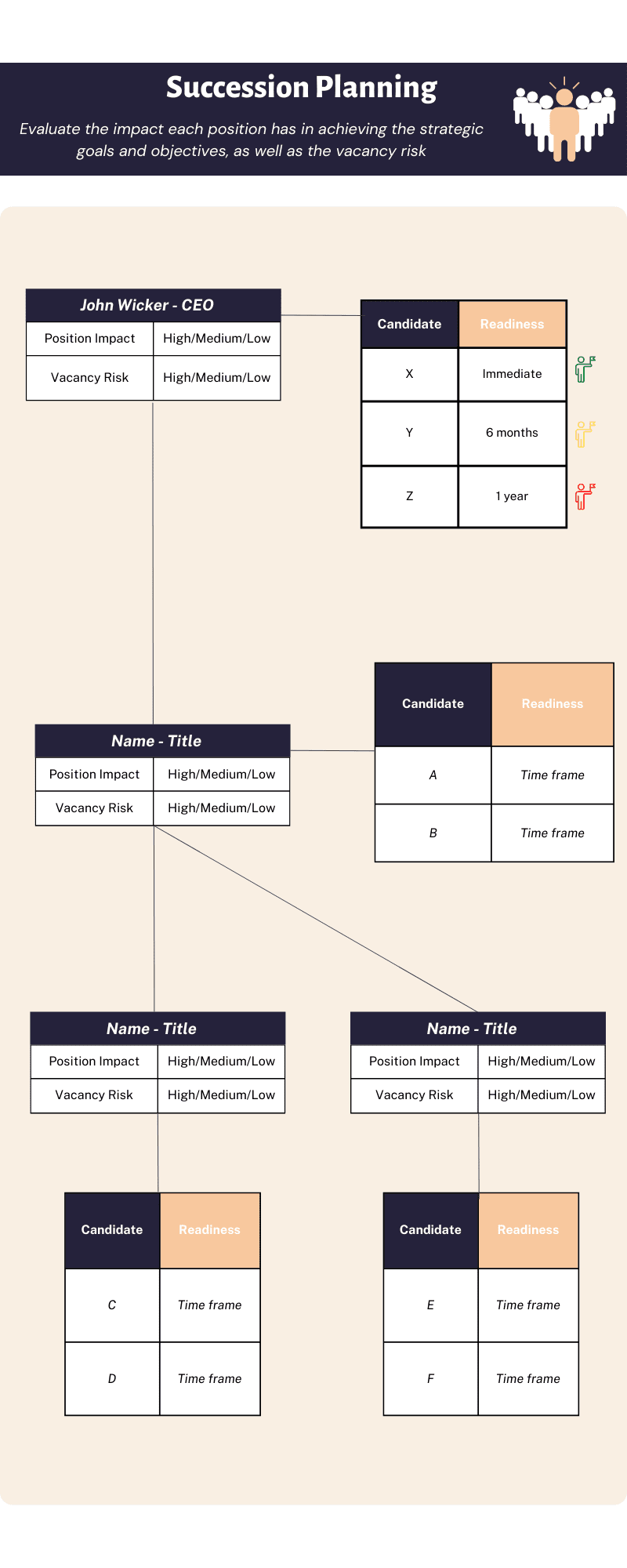
3. Identify business challenges over the next 1-5 years
Another factor to consider in your succession plan is identifying any business challenges in the next 1-5 years. An environmental scan will provide you with enough information to begin the succession planning process. Environmental scans are conducted during a brainstorming session at a team meeting or surveying or talking with stakeholders.
Here’s what your environmental scan worksheet will look like.
What’s happening inside and outside your organization:
Right now | In the near future | In the distant future |
|
4. Identify competency and skill gaps
After you determine which positions are mission-critical and have a significant vacancy risk, the next step is to define the core competencies that are must-have success factors for each position.
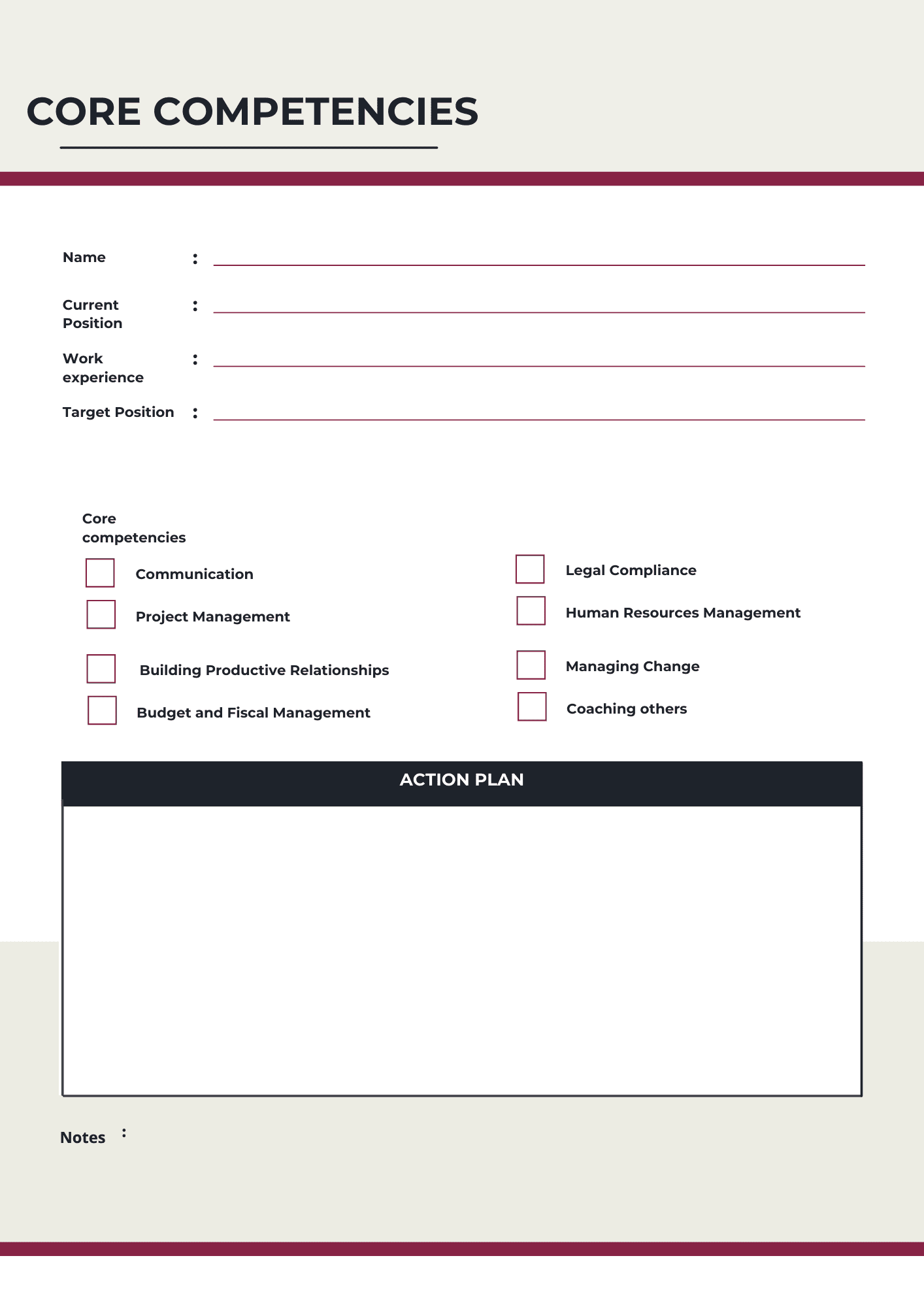
5. Create an action plan to prepare successor(s)
Creating a developmental plan for potential successors helps employees acquire the required competencies to progress in the organization. An employee development plan combines formal training, thoughtful coaching, trusted mentorship, and key assignments.
Creating a development plan for a successor includes:
- Creating a training plan with learning and development opportunities aligned with the successor’s position.
- Mentoring from the current leadership.
- Coaching opportunities.
- Working on special projects or opportunities to stretch skills into aligned areas.
- Mentorship and networking opportunities with more senior members of the organization.
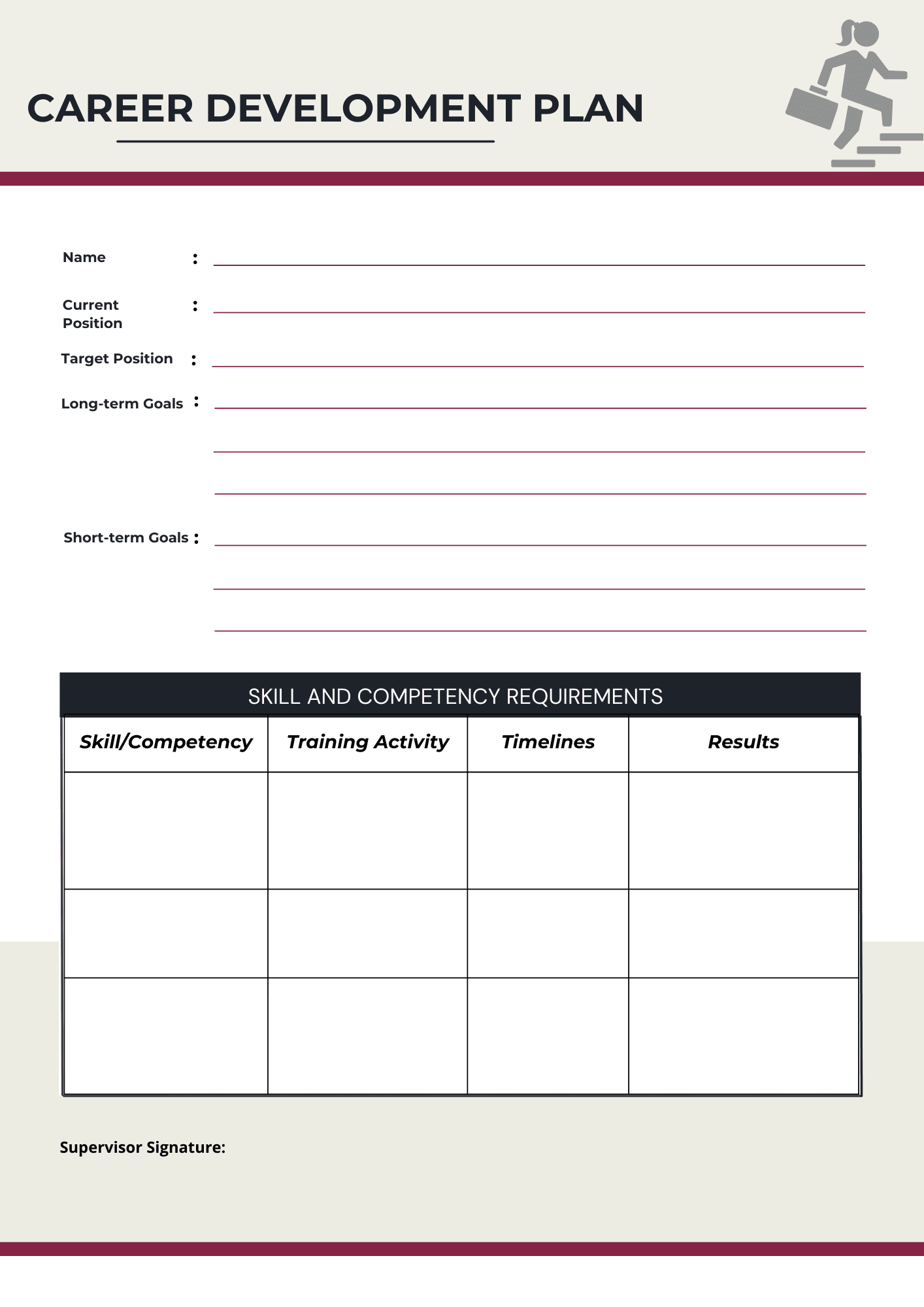
6. Evaluate the succession plan
Since you’ve dedicated many hours to your succession plan, take time to monitor the success of your efforts and make a plan to correct any pain points. Evaluating your organization’s succession plan annually allows you to continuously refine your strategy.
To evaluate your succession plan, consider the following:
- Your organization’s bench strength, both before and after the succession plan.
- The number of “ready now” successors before and after the succession plan.
- Overall improvement in employees’ performance.
- Whether there is reduced risk associated with employee turnover.
Free Succession Plan Template
To help you create your own succession plan, we’ve created a free succession plan template to help your get started. You can download and customize this template below:
✓ Thank you, the checklist will be sent to your email
For companies, the benefits of succession planning are clear and significant. In addition to adding fresh perspectives and enhancing the workplace culture, creating a succession plan helps companies thrive by driving innovation, increasing revenue, and attracting top talent. It also helps to provide a proactive solution to people-based business continuity risks.
Organizations should invest in digital adoption platforms such as Whatfix to find the maximum ROI on their employee learning and development programs.
Using a DAP as your training software empowers employees to upskill themselves on the latest tools, applications, and digital processes without disrupting their workflow and productivity. It’s the best resource to make your employee development plans future-ready and valuable.
With Whatfix, L&D teams are empowered with no-code tools to create in-app guided content, such as step-by-step flows, interactive walkthroughs, task lists, smart tips, and self-help knowledge bases that overlay on your digital applications and processes.
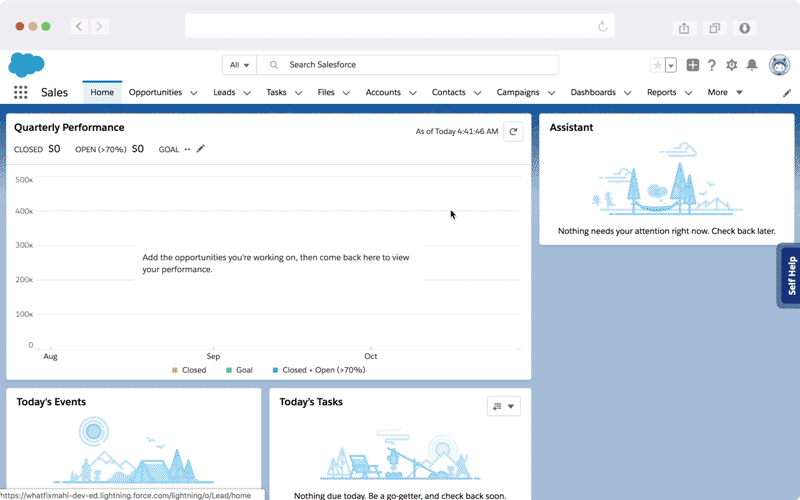
Organizations are able to capture employee event data to understand how their workforce is engaging with their digital applications, allowing L&D teams to understand the levels of software adoption, feature adoption, digital skill gaps, and more – and to refine their onboarding, training, and development programs.
You can learn more about Whatfix for Learning & Development Professionals here.
Request a demo to see how Whatfix empowers organizations to improve end-user adoption and provide on-demand customer support
Thank you for subscribing!


